7 Barriers Preventing Your Agency From Doing Effective Link Building
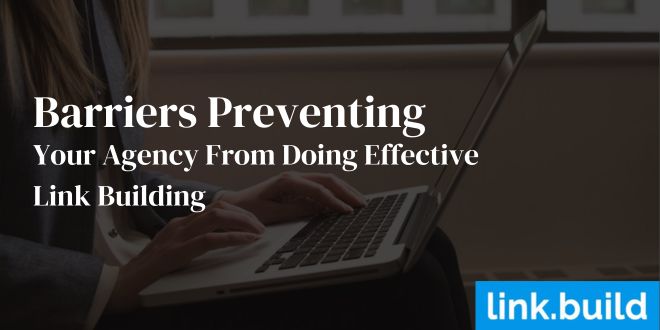
SEO agencies serve a wide range of needs, from the major corporation that needs to outsource some of the work that its in-house team can't handle, to the fresh entrepreneur who doesn't know the first thing about SEO and needs some seasoned guidance.
Unfortunately, even talented agencies with years of experience sometimes struggle to attract and retain clients on the SEO front. SEO has a few factors working against it; it's a complicated strategy that involves lots of moving parts, it's hard to objectively quantify your results, and even when you do, those results take lots of time and patience before they start justifying your costs. Accordingly, I've seen a number of agencies straining in recent years, sometimes going under, and sometimes dropping an entire wing of service from their lineup.
One critical aspect of SEO that many agencies often focus on is link building. Link building is a vital part of SEO because it helps improve a website's authority and visibility in search engines. Through link building, agencies aim to acquire high-quality backlinks from reputable websites, which can boost a site's search engine rankings and drive more organic traffic. Without effective link building, SEO efforts can be less effective, making it even more challenging for agencies to demonstrate their value to clients. Therefore, mastering link building strategies is essential for SEO agencies to help their clients achieve sustainable success in the competitive online landscape.
One of the first services to fold, it seems, is link building. Why is this?
For starters, it’s confusing. On one hand, you have Google engineer John Mueller telling you not to link build at all, and on the other you have respected SEO authority Moz telling you it’s almost impossible to rank without it—domain-level and page-level link influence adds up to nearly 40 percent of a page’s ranking influencers.
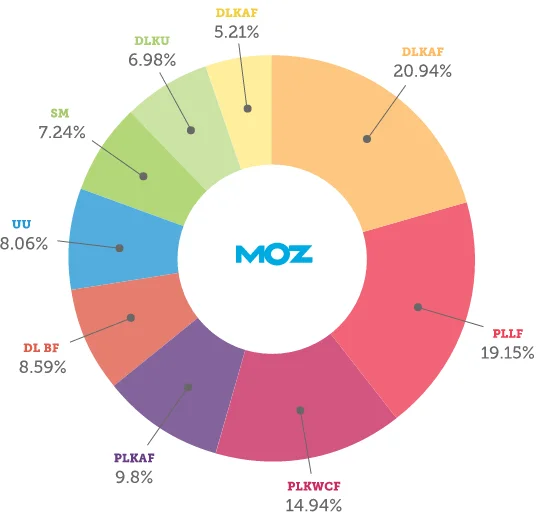
(Image Source: Moz)
Add in the fact that link building parameters keep changing with Penguin (and dynamics within publishers), and the fact that it's notoriously hard to tie efforts to results, and you have, on the surface, a challenging, unpredictable link building strategy.
So why do it at all? Because it's valuable. Incredibly so. That is, if you can get past the barriers that typically lead agencies to flounder.
In my experience, both as an agency owner and as a whitelabel provider to agencies, there are seven main barriers preventing effective link building. I'll address these one by one.
Barrier 1: Understanding the Client
Imagine you have two single friends. You know them well, they seem to have a lot in common, and they seem like they could get along. You might consider setting them up on a blind date—and you'd have reason to suspect that date would go well. Now, what if you tried to set up the random man you sat next to on the subway with the random lady you saw across the street? You have no idea, because you don't know these people well enough to gauge their potential chemistry.
This is a colorful and imprecise analogy, but it serves a valuable purpose in identifying link building as a relationship game. It's no longer enough to build random links pointing to any domain; those links need to be relevant, surrounded with great content, and hosted on sources appropriate to the target domain. How can you expect to accomplish any of these if you don't know your client that well?
In the world of SEO, effective link building strategies require a deep understanding of your client's goals, industry, and target audience. Just as in setting up friends on a blind date, establishing successful link building relationships hinges on knowing the parties involved and ensuring that the connections made are meaningful and relevant.
Ask yourself these questions:
- What does this client do? This may seem like a laughably simple question, but you’d be surprised how many agencies fail here. You might have a highly technical SaaS provider, or a specialized manufacturer, whose jargon-laced company descriptions make them hard to penetrate. This should dictate the type of topics you choose for your link building campaigns.
- Who is their target audience? You don’t have to write every piece of offsite content to please one specific target audience, but this should help you decide on an initial list of sources and publishers.
- What is their industry? The contextual relevance of your links is partially determined by the relationship of your link source to your client’s industry. Can you identify that industry?
- What unique value do they offer? This isn’t limited to their products and services, either; what unique research do they publish? What unique content do they have on their blog? These are valuable linkable assets you can use to build stronger, more relevant links on your outbound sources.
It might be embarrassing to ask these questions, especially if you’ve been working with this client for a while, but these answers will allow you to build stronger, more relevant, more valuable links on more valuable, appropriate sources. If you don’t know the answers to any of these questions, you’ve been firing blind in your strategy.
Barrier 2: Outdated Practices
Link building has changed dramatically since the early days of SEO. There have been dozens of updates and tweaks, but the big game changer here was Penguin.
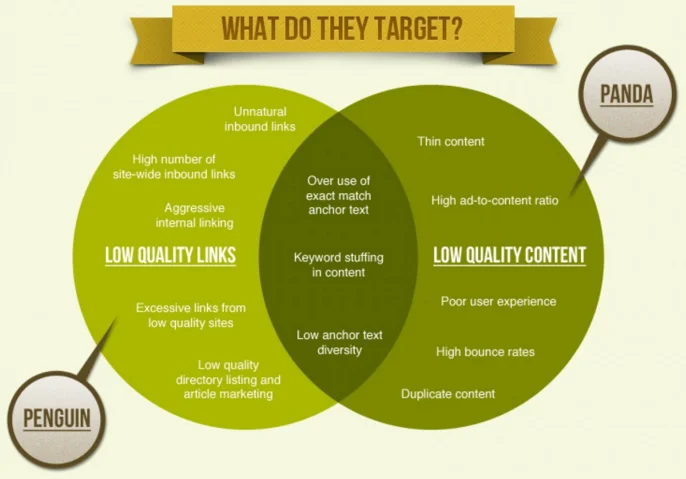
(Image Source: No Pork Pies)
This is a basic visual from not long after Penguin’s first arrival, but it helps you understand some of the basic link building practices that are, essentially, “dead:”
- Links that appear unnatural.
- Links that aren’t useful.
- Links stuffed with exact-match anchor text or keywords.
- Links using repetitive anchor text.
- Links pointing to the same URL over and over.
- Too many links from one source.
- Links from low-quality or irrelevant sources.
- Links from schemes (too many to list here).
It also helps you understand the dynamic relationship between link building agencies and content, which I'll elaborate on in the next section.
Unfortunately, even knowing about the major changes of the Penguin update, many link building agencies continue to use obsolete practices, such as posting links in forum comments or spamming links on outside sources without much consideration to their relevance or diversity.
Modern practices demand a more refined approach, usually centered on establishing and developing relationships with a plethora of offsite authorities, especially those related to your client's industry, or those with a national presence. This demands a lot of work; you'll spend far more time and energy per link than you would with an old method, but it's worth it. Too many agencies don't realize this, and opt for the cheaper, easier "old school" methods in the hopes that they'll yield some kind of benefit. Believe me, you get what you work/pay for here.
Barrier 3: Content Quality
After peeking at this title, you’re probably asking yourself, “Content? Shouldn’t content be a separate strategy from link building?” Yes and no. Ongoing onsite content (e.g., a blog) is important to add more indexable, valuable material to your site (and provide more linkable assets), but as we saw in the last barrier, in the post-Penguin era, content is important for offsite link building, too.
In fact, there are four major ways content affects your link building strategy:
- It helps determine the strength of your inbound link. Imagine two articles on a similar domain, featuring a similar link and covering a similar topic. One is highly detailed, thousands of words in length, with multimedia integrations and an authoritative, playful voice. It’s generated thousands of shares and is visited regularly. The other is short, fluffy, awkward-sounding and has generated almost zero shares or visibility. Which link passes more value to its target domain? The former. The quality of your content plays a major role in how much authority is passed to high-quality links, so the better material you produce, the more value the link will hold on your own website.
- It determines whether or not your content is published. This is especially true as you aim to be published on more authoritative sources. High-authority sites got to be where they are because they're discriminating when it comes to content. They only want truly valuable, relevant pieces that their readers are going to love. If you submit something hastily written, or poorly conceived, it's going to be rejected—and your efforts to acquire backlinks will be wasted. To secure placements on authoritative sites and secure natural backlinks, you need to consistently produce engaging content that meets their high standards. High-quality, top-notch links are earned through the delivery of compelling content.
- It influences your relationships with other sites. When you try to start a relationship with a new publisher, they're going to look at work you've posted on other publishers. Providing universally solid content, capable of impressing even the most judicious editors, will help you build relationships with those new sites. This is particularly important if you're working on improving your search engine ranking position, guest posting on a blog, or trying to disavow low-quality backlinks to enhance your search results. Your ability to consistently produce high-quality content plays a significant role in tracking progress and building positive relationships with new publishers on relevant websites, which is essential for successful link acquisition.
- It affects reader impressions and referral traffic. If readers are enthralled by your material, they'll be excited to follow your link, especially when you're building links, and will come to the site with a more impressed, positive disposition. If your content doesn't grab a reader, they may not even finish reading the article, and you can kiss that referral traffic, along with potential link building opportunities, goodbye.
Every offsite post you produce needs to be relevant, unique, valuable, practical, and engaging. If you lack any of those qualities, the efficiency of your strategy could crumble.
Moral of the story? Be as discriminating with your offsite content as you are with your onsite content.
Barrier 4: Publication Networks
The authoritative strength of your source domain (and page) matters to the overall value of the link. If you want to see the highest return on your time investment, you need to choose the sites that offer the highest possible authority to link opportunities.
For this, you don't have to rigorously calculate the domain authority of the external sources you're considering, nor do you have to rule out any source that isn't perfect. You can use your best judgment, based on what you know about the site, to determine whether a source is worth pursuing to build links.
For example, which of the following two sites would be better to build a link on?
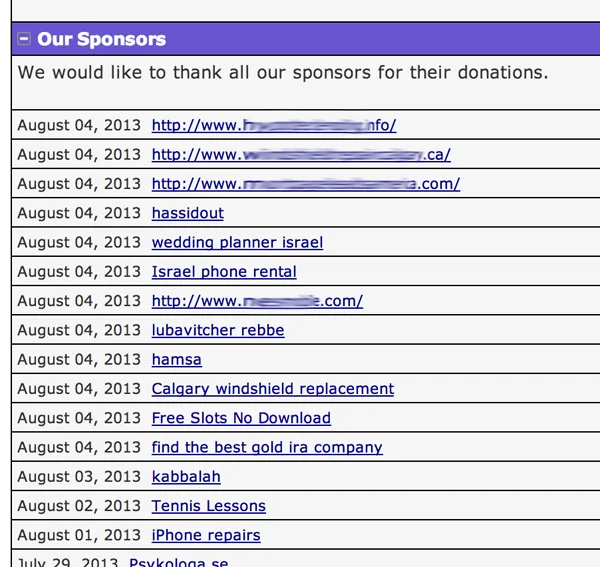
(Image Source: Moz)
The second will provide a massive boost to your domain authority, and the first might get you penalized.
It pays to be discriminating. Consider the old Groucho Marx quote: “I refuse to join any club that would have me as a member.” If your target source is the type that will accept any content, or any link, it probably isn’t a source worth building a link on. On the other hand, if it takes time, effort, a pre-existing relationship, and a little luck to do link building, your dutiful efforts are justified. It is hard to build links this way, but that’s what separates successful link building agency from mediocre ones.
Barrier 5: The Ability to Scale
When you first start link building efforts for a client, you have to start easy. You have to find sources willing to link to a newcomer and get published on lower-tier sources before you start building a reputation. After a while, you’ll land yourself on some decent sources that pass a decent amount of authority to your client’s domain.
The problem is, most agencies stop here. They see their efforts have returned a valuable position, and they keep repeating the process ad infinitum, occasionally adding new sources but ultimately keeping their strategy consistent. They have no ability to scale, and as a result, the campaign begins to see patterns of diminishing returns.
If you want to keep seeing growth in a campaign, you can’t keep your efforts consistent. There is no “cruise control” for link building efforts unless you don’t want to see any growth. Instead, you have to gradually ratchet up your efforts.
For example, consider a restaurant getting a link from this site, a local news outlet:
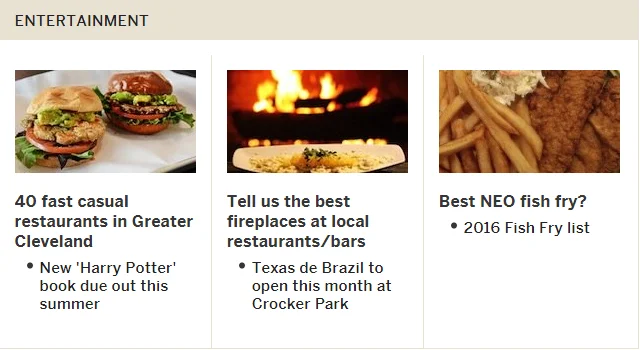
(Image Source: Cleveland.com)
Is this out of reach for you? Yes. But only in the same way that running a marathon is out of reach. You can’t go from barely ever exercising to running a marathon; you have to go from 1 mile to 2, from 2 to 3, and so on iteratively until you can handle the distance. Similarly, you have to find “missing link” sources to bridge the gap between your current authoritative reach and the pinnacle of industry success.
Again, this takes time and effort, but it’s how you can distinguish yourself from the competition and continue to prove your worth to the client.
Barrier 6: Optimizing Costs
Okay, let’s take a step back and remember that “effective link building” isn’t all about getting the best results when you’re an agency trying to make a profit at the same time. Yes, you truly want your client to succeed, but if you’re spending more time and money than you’re earning from your client’s retainer, you’re ultimately putting your business (and your employees) in a tight position.
The costs of link building campaigns are difficult to calculate because they’re based on time, and if you have multiple employees dabbling in the process, it’s almost impossible to calculate how much time they’re spending on a given client’s link building efforts. For example, you might have a team lead who coordinates the strategic directives, a staff writer who generates the content and includes the link, and a relationship manager who takes care of posting and monitoring. Ultimately, just one good link can take 4-8 hours of time to build, maybe even more for long-form content or choosy publishers, and that doesn’t even include the costs of maintaining your ongoing relationships! Even at a modest agency rate of $100 an hour, that’s $800 you’d charge your client for a single link, and depending on what you charge for ongoing “SEO services,” that can eat up your budget in no time.
So let’s look at the ways you can optimize these costs:
- Build more links at once. If you’re already writing and publishing guest content regularly, you can streamline the process by having members of your team hyper-specialize in certain elements of the process. This creates an assembly-line setup, which allows you to increase overall productivity; the problem is the overhead, and the time it takes to establish such a system. If you only have a few link building clients, this is hard to justify.
- Spend less time. The “shortcut” way is to simply force yourself to spend less time on link building in general. You might go after lower-level sources, rush the writing process, or use the same sources over and over. The problem here, as you can imagine, is that the time you spend really is valuable, and if you spend less of it without a corresponding increase in efficiency, you’ll end up earning less overall value.
- Outsource the work. Think of the infrastructure I mentioned in my first point. What if you could achieve it without the overhead costs or complexities of training an entire team? Outsourcing overrides the necessity for these steps. By working with a link building specialist, you’ll be able to build better links on higher-authority publishers for less initial cost. The trick here is to find an agency worth doing business with. There’s no shortage of link builders out there, but only a handful that approach the strategy properly, with modern tactics. Don’t take “link building,” as a service, at face value. Ask questions of your agency, find out what strategies they’re using, and only recruit the services of a long-term partner who can stand behind their work.
Building valuable links without spending more money than you’re earning is a difficult balance to strike, but optimizing your costs is a good way to start. This balance is also responsible for another barrier in link building agency relationships: proving your links are worth the cost to the client.
Barrier 7: Proving Your Worth
Your client is paying you good money for SEO services. You may keep most of your work behind the scenes, but there are two instances where your client will start questioning your link building services:
- Your client is unsatisfied with your overall results. Maybe your traffic isn’t increasing, or your ranks have gone stagnant. Whatever the case, your overall SEO results leave something to be desired, and your link building efforts come under scrutiny as part of a collective whole.
- Your client learns how much time you spend on link building. In this scenario, your client is unconvinced that link building is worth the time you put into it. They may feel you’re wasting time and money by building links that could be spent doing something better to increase rank.
If you want to attract and retain the best clients, your two goals then should be proving the return of your SEO campaign, and proving the value of your link building strategy, in particular. There are several ways to do this, but I’m going to highlight some of the most effective.
Organic Traffic
Organic traffic is one of the best measures you have as a link building agency for the overall health of your SEO campaign. It measures the number of people who found your client’s site through search engines, so the higher this number, the more effective your campaign has been, and you can easily measure growth over time. It’s advantageous over measuring ranks directly, because ranks can be deceptive—after all, what good is a number one position if it doesn’t earn you any real traffic?
To find this figure, log into Google Analytics and select your client. Head to the Acquisition tab and click Overview to see a breakdown of your client’s major traffic sources.
Over time, your Organic traffic will likely grow in comparison to your other sources (as will Referral traffic, but we’ll get there in a moment). You can use this as a basis for your value as an agency.
Now, scroll down and click “Organic Traffic” to see a breakdown of just your Organic users.
Ordinarily, it’s a bad idea to look at fluctuations on a daily basis; rankings are volatile. However, you can use this to help you find specific effects your link building strategy has had. For example, let’s say you’ve posted two new links on new high-profile sources for your client. A few days later, there’s a spike in organic visits. In this case, you can almost objectively tie your link’s value to your pattern of growth in organic search results.
Referral Traffic
Don’t forget that organic ranks aren’t the only benefit that successful link building campaign yields. Head back to the Acquisition Overview section and this time, pull up Referral traffic. This is a breakdown of all the inbound traffic your client received from click-throughs on external links. Scroll down a bit and you’ll find the breakdown.
Here, you can find tons of information—including total number of visitors—from each of your referral sources. Assuming you know the average value of a visitor (which you can calculate using average conversion rates, conversion values, and long-term customer value), you can objectively calculate the value of a link. Keep in mind this value will be a minimum, as the traffic will only grow over time.
Overall Link Evaluation
You can also prove your link building agency’s worth by showcasing the total growth of links as it relates to domain authority, one of the best measures of a domain’s potential to rank. You’ll have to use another tool for this; one of my favorites is Moz’s Open Site Explorer, which is partially free.
Enter any domain, and you’ll find domain-related and page-related metrics, such as domain authority, page authority, total links, and root domains.

(Image Source: Moz)
You’ll also be able to generate a list of each individual link, along with its respective authority scores, which you can export as a CSV file. This is useful not only for showing the ongoing value of your work, but identifying key areas for improvement as well.

(Image Source: Moz)
The goal here is to show your ethical link building practices and growth and tie that to authority growth; tying those to monetary value may require additional metrics, such as the ones I referenced above.
Secondary Values
The main priorities for tiered link building opportunities are building higher search ranks and generating more traffic, both of which generate revenue for a site. However, there are also other, less tangibly measurable values that link building can add:
- Brand visibility. Every new post that references your client means a further reach for your client’s brand. Not everybody will follow the link immediately, but everybody will see that brand name and remember it.
- Brand reputation. People will associate your client as an authority in the industry (if the content is strong), which leads to more referrals, more future sales, and more loyal customers.
- Social clout. If users aren’t interested in visiting your client’s site or buying, they may still engage your client socially thanks to your increased presence, adding to a pool of potential marketing targets.
- Ongoing growth. As external links are semi-permanent, they tend to grow in value over time for search engines. Any metrics you show are only in-the-moment snapshots of value; they don’t tap into the long-term potential of your work.
Don’t forget to mention these when proving your value to the client.
Conclusion
I didn't say overcoming these barriers was easy, or even straightforward, but with time and effort, you can turn your link building strategy into one that both you and your clients will swear by. Remember, you don't have to do this alone; rely on the experience and content of others to help guide you whenever you run into obstacles, and don't be afraid to outsource elements of your strategy to a firm that's better qualified to handle link building responsibilities. Link building success is too important to SEO and search engines to ignore, and if done incorrectly, can compromise the ROI of your entire campaign or the relationships of your most important clients.


.svg)

.jpg)
.jpg)
.jpg)